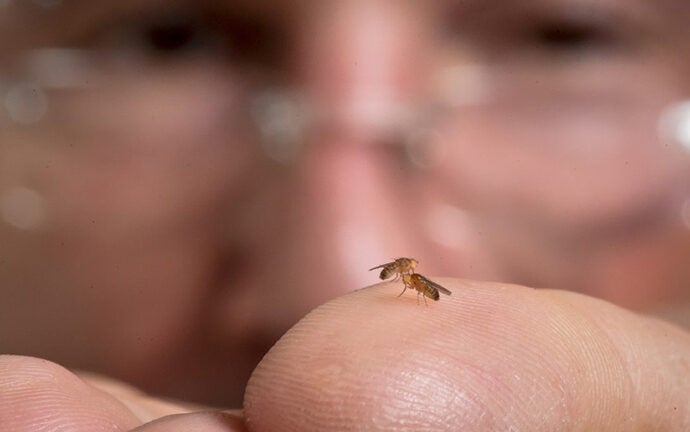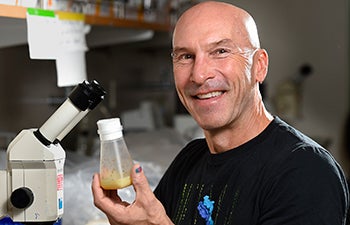
Some aging treatments have opposite effects on males and females
What helps her live longer might be harmful to him, according to a new study that may shed light on how and why organisms age.
Analyzing years of previous research on dietary and pharmaceutical tests on flies and mice, researchers showed that aging interventions can have opposite effects on mortality rates in males versus females. The findings appear consistent with data gathered on humans, as well, said lead researcher John Tower, professor of biological sciences.
Tower and his colleagues found that treating flies with the steroid hormone mifespristone/RU486 (used in humans for terminating pregnancy) decreased egg production in females while increasing longevity.
Similar effects were seen by tweaking the diets of flies and mice, but the effects were sometimes opposite in males versus females.
Longer living means faster dying
Increasing lifespan also increased the acceleration of the age-dependent mortality rate of the population. In other words, individuals generally lived longer, but the population dwindled faster and faster as the group aged.
According to the researchers, that’s evidence of a strong Strehler-Mildvan relationship, which is a model for mortality in a population.
To illustrate the Strehler-Mildvan model, if a person created a graph of the mortality rate of everyone born in a given year, tracking them from birth until the last person died, the line would rise very slowly in the beginning then rapidly curve upward toward the very end.

John Tower, professor of biological sciences at USC Dornsife.
In other words, there’d be a small number of individuals dying here and there, typically due to infections and pathogens. That’s non-age-driven mortality. Then, as the group aged, the mortality rate would rise exponentially until the last person died. This acceleration of mortality is thought to represent true aging — the inexplicable breakdown of the body over time.
“We all speculate, but no one has really figured out what the cause of that acceleration is,” Tower said. “Our results show that dietary and genetic interventions sometimes have opposite effects on that acceleration in males versus females.”
The combination of age-driven and non-age-driven mortality is described mathematically by the Gompertz equation, named for the British mathematician who first suggested it in 1825.
What the Strehler-Mildvan relationship implies is that this equation is affected by the mixture of strong and weak individuals in a population, and that if you change the mixture, the mortality rates will adjust accordingly.
“There are weaker, low-vitality individuals in the population, and if you kill them off, you’re left with high-vitality individuals and the population has a slow mortality acceleration with age,” Tower said. “The relationship was so striking in how robust it was in the data we analyzed. I’ve never seen numbers like that. It confirms that this is a very fundamental relationship.”
Does nature favor some genes that kill us?
Tower says that the findings would also seem to support the antagonistic plieotropy model for aging, proposed in 1957 by evolutionary biologist George Williams. In part, the model tries to explain why our bodies ultimately break down and die.
Williams suggested that natural selection might select for a gene that creates a fatal flaw later in life if it offers some significant benefit earlier — that is, if it helps individuals reproduce successfully, it’s beneficial to the species as a whole even if it does ultimately shorten the individuals’ lifespans. (“Pleiotropy” refers to a single gene that affects multiple physical characteristics.) Such genes would, against common wisdom, be selected for.
The mifespristone intervention appears to prevent such a trade-off between lifespan and reproductive ability — albeit, a sex-dependent one.
The antagonistic pleiotropy model has received a number of criticisms over the past half-century, with some scientists suggesting that if it was really the driving force behind aging, somewhere in the history of evolution, some organism should have been able to overcome it.
Tower’s study supports the idea that sexual antagonistic pleiotropy — where a gene benefits one sex but has a detriment for the other — keeps genes in the genome that shorten life span of both sexes.
The study was published on Feb. 18 in the Journal of Gerontology: Biological Sciences. Tower’s coauthors include Visiting Scientist Gary Landis of USC Dornsife and Jie Shen of Hangzhou Dianzi University.
The research was funded by the Department of Health and Human Services (grant AG011833); the Southern California Environmental Health Sciences Center (grant 5P30ES007048); the Returned Overseas Chinese Scholars Research Merit Aid; and the National Natural Science Foundation of China (31500970).